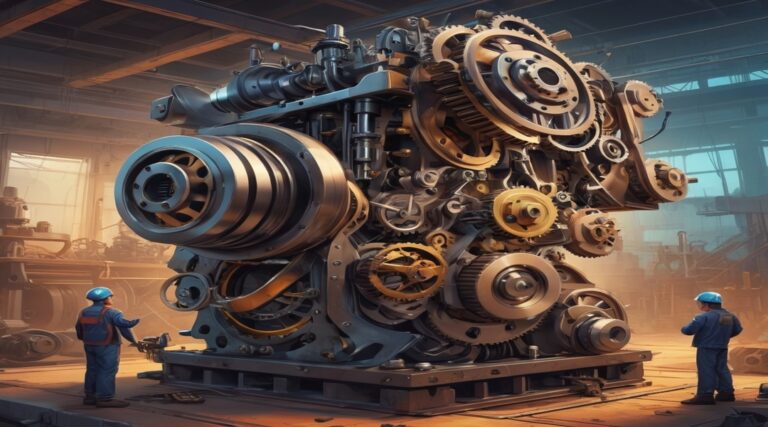What Is Mechanical Design? 9 Ways It Shapes Modern Industry
From the smartphone in your pocket to the vehicle you drive, mechanical design is the invisible force that brings countless innovations to life. At its core, mechanical design is the creative process of developing physical systems that solve real-world problems through engineering principles. This fascinating field combines creativity, mathematics, physics, and material science to create solutions that power our modern world.
Whether you’re considering a career in engineering or simply curious about how the objects around you come to life, understanding mechanical design opens a window into the way our physical world is engineered. In this comprehensive guide, we’ll explore what mechanical design is, the essential skills mechanical design engineers need, and the nine critical ways this discipline shapes industries from automotive to aerospace, consumer products to renewable energy.
By the end of this article, you’ll gain a deeper appreciation for the mechanical design process that transforms abstract ideas into tangible, functional products that improve our daily lives. Let’s dive into the world of mechanical design and discover how it continues to drive innovation across the industrial landscape.
Table of Contents
What is Mechanical Design?
Mechanical design is the systematic process of creating mechanical systems, components, and products that can perform specific functions while meeting various constraints and requirements. It’s the bridge between conceptual ideas and physical reality, transforming theoretical concepts into tangible objects that can be manufactured and used in the real world.
At its foundation, mechanical design involves applying engineering principles, mathematical models, and material science to develop solutions that address specific needs or problems. Unlike purely aesthetic design, mechanical design focuses primarily on functionality, reliability, safety, and manufacturability, ensuring that products not only look good but work efficiently and effectively for their intended purpose.
The field encompasses everything from designing simple mechanical components like gears, springs, and levers to creating complex systems like automobile engines, industrial machinery, and aerospace equipment. A mechanical design engineer must consider numerous factors in their work, including material properties, environmental conditions, manufacturing capabilities, economic constraints, and user requirements.
Modern mechanical design has evolved significantly with the advent of sophisticated computer-aided design (CAD) tools, simulation software, and advanced manufacturing technologies. These developments have transformed the way mechanical design engineers approach their work, making the process more efficient, precise, and innovative than ever before.
Key Elements of Mechanical Design
Mechanical design is a multifaceted discipline that incorporates several essential elements to bring functional products to life:
1. Engineering Fundamentals
At the heart of mechanical design are solid engineering principles. Successful mechanical design relies heavily on a deep understanding of:
- Applied mechanics: How forces and energy affect physical systems
- Strength of materials: Understanding how materials respond to applied forces
- Thermodynamics: The science of heat, energy, and work
- Fluid mechanics: How liquids and gases behave under various conditions
- Machine elements: The building blocks of mechanical systems like bearings, gears, and fasteners
Mechanical design engineers must master these fundamentals to create systems that perform reliably and safely under various operating conditions.
2. Material Selection
Choosing the right materials is crucial in mechanical design. Engineers must consider:
- Physical properties (strength, weight, flexibility)
- Thermal properties (heat resistance, conductivity)
- Chemical properties (corrosion resistance, reactivity)
- Manufacturability (how easily the material can be formed, machined, or joined)
- Cost and availability
- Environmental impact and sustainability
The selection of materials significantly influences a product’s performance, lifespan, and cost-effectiveness.
3. Design Methodology
Modern mechanical design follows structured methodologies that typically include:
- Requirement analysis: Defining what the design must accomplish
- Conceptual design: Generating ideas and potential solutions
- Detailed design: Developing comprehensive specifications and models
- Analysis and optimization: Testing designs through calculations and simulations
- Prototyping: Creating physical models for testing
- Design validation: Ensuring the design meets all requirements
- Documentation: Creating detailed specifications for manufacturing
These methodologies help ensure that designs are developed systematically and thoroughly.
4. Computer-Aided Design (CAD)
Today’s mechanical design is inextricably linked with 3D mechanical design software. CAD tools have revolutionized the field by enabling:
- Creation of precise 3D models and 2D drawings
- Virtual assembly and fitting of components
- Simulation of physical behaviors and forces
- Detection of design flaws before manufacturing
- Easier collaboration among design teams
- Faster design iterations and modifications
Popular mechanical CAD systems include AutoCAD for mechanical engineering applications, SolidWorks, Autodesk Inventor, and CATIA, which have become indispensable tools in the mechanical design engineer’s toolkit.
9 Ways Mechanical Design Shapes Modern Industry
Mechanical design’s influence extends across virtually every sector of the economy. Here are nine key ways it shapes our modern industrial landscape:
1. Automotive Innovation
The automotive industry relies heavily on mechanical design for everything from engine components to suspension systems, body structures, and interior mechanisms. Mechanical design engineers in this field focus on improving:
- Fuel efficiency through lightweight materials and aerodynamic designs
- Safety features like crumple zones and restraint systems
- Powertrain performance and reliability
- Manufacturing efficiency and cost reduction
- Electric vehicle systems and battery integration
The evolution of transportation technology, from traditional combustion engines to hybrid and fully electric vehicles, represents a triumph of mechanical design adaptation and innovation.
2. Aerospace Advancement
In aerospace, mechanical design tackles extreme challenges of performance, reliability, and safety. Key contributions include:
- Lightweight yet strong airframe structures
- High-efficiency propulsion systems
- Complex landing gear mechanisms
- Flight control surfaces and systems
- Environmental control systems for cabin comfort and safety
Opto-mechanical design, which combines optical and mechanical elements, is especially important in aerospace for creating guidance systems, sensors, and communication equipment.
3. Medical Device Development
Mechanical design plays a crucial role in creating life-saving and life-improving medical devices:
- Surgical instruments that enable precise procedures
- Prosthetic limbs and implants that restore function
- Diagnostic equipment that aids in identifying health issues
- Drug delivery systems that administer medications effectively
- Rehabilitation equipment that assists in recovery
The precision and reliability demanded by medical applications make this one of the most exacting fields for mechanical design services.
4. Energy System Innovation
As the world transitions to more sustainable energy sources, mechanical design is at the forefront:
- Wind turbine design optimization for maximum energy capture
- Solar tracking systems that follow the sun’s path
- Hydroelectric turbines that efficiently convert water flow to electricity
- Thermal management systems for nuclear power
- Energy storage solutions that address intermittency challenges
Mechanical design engineers working in this sector must balance performance with durability, often designing systems that must operate reliably for decades with minimal maintenance.
5. Manufacturing Equipment Creation
The machines that make our products are themselves masterpieces of mechanical design:
- Automated assembly lines that increase production efficiency
- Precision machining equipment that creates complex components
- Robotic systems that perform repetitive or dangerous tasks
- Material handling systems that move products through factories
- Quality control equipment that ensures product consistency
Mechanical design firms specializing in manufacturing equipment must understand not only mechanical principles but also the specific requirements of different manufacturing processes and industries.
6. Consumer Product Development
From kitchen appliances to smartphones, mechanical design shapes the products we use daily:
- Ergonomic designs that enhance user comfort and accessibility
- Mechanisms that make products more functional and intuitive
- Durable components that withstand regular use and abuse
- Miniaturization techniques that pack more features into smaller packages
- Sustainable designs that reduce environmental impact
The integration of mechanical design with industrial design is especially important in this sector, where aesthetics and user experience are as important as functionality.
7. Infrastructure and Construction
Mechanical design contributes significantly to the built environment:
- HVAC systems that maintain comfortable indoor environments
- Elevators and escalators that transport people within buildings
- Water treatment and distribution systems
- Bridge mechanisms like expansion joints and movable spans
- Construction equipment that enables building complex structures
Mechanical design engineers in this field must create systems that operate reliably for decades while serving the needs of building occupants and users.
8. Robotics and Automation
The growing field of robotics relies heavily on mechanical design for:
- Articulated joints and movement mechanisms
- End effectors and manipulation tools
- Locomotive systems for mobile robots
- Structural frameworks that balance strength and weight
- Integration of sensors and actuators with mechanical components
This field exemplifies machine design as an integrated approach, combining mechanical, electrical, and software elements into cohesive systems.
9. Defense and Security Applications
Mechanical design plays a vital role in defense systems:
- Vehicle armor and protection systems
- Weapon systems and deployment mechanisms
- Unmanned vehicles for reconnaissance and combat
- Field equipment designed for extreme conditions
- Secure storage and transport systems for sensitive materials
The demanding requirements of defense applications often drive innovations that later find applications in civilian sectors.
The Mechanical Design Process
Creating successful mechanical designs involves a structured approach that mechanical design companies typically follow:
1. Problem Definition and Requirement Specification
The process begins by clearly defining the problem to be solved and specifying the requirements the design must meet. This includes:
- Performance requirements
- Environmental conditions
- Cost constraints
- Manufacturing considerations
- Regulatory compliance
- User needs and expectations
A well-defined problem statement and comprehensive requirements specification provide the foundation for all subsequent design work.
2. Conceptual Design
During this phase, engineers generate multiple potential solutions to the problem. Activities include:
- Brainstorming sessions
- Sketching preliminary ideas
- Creating simple models to test concepts
- Evaluating different approaches
- Selecting the most promising concepts for further development
This phase emphasizes creativity while remaining grounded in engineering fundamentals.
3. Detailed Design and Analysis
Once a concept is selected, it’s developed in detail using:
- 3D CAD modeling to create precise digital representations
- Engineering calculations to determine dimensions and specifications
- Finite element analysis (FEA) to simulate structural behavior
- Computational fluid dynamics (CFD) to analyze fluid interactions
- Motion simulation to verify mechanical movements
This stage transforms rough concepts into detailed designs with specific dimensions, materials, and specifications.
4. Prototyping and Testing
Physical prototypes help validate design assumptions:
- 3D printing for rapid creation of complex parts
- CNC machining for more precise components
- Assembly of prototype systems
- Performance testing under various conditions
- Identification of design weaknesses or failures
Prototyping provides crucial feedback before committing to full-scale production.
5. Design Refinement
Based on prototype testing, the design is refined to:
- Address any performance issues
- Improve manufacturability
- Reduce costs
- Enhance reliability and durability
- Optimize for user needs
This iterative process may involve multiple cycles of testing and refinement.
6. Production Documentation
Finally, comprehensive documentation is created for manufacturing:
- Detailed engineering drawings
- Bill of materials (BOM)
- Assembly instructions
- Quality control specifications
- Maintenance recommendations
This documentation ensures that the design can be consistently manufactured to specification.
Essential Skills for Mechanical Design Engineers
Success in mechanical design requires a diverse skill set:
Technical Knowledge
- Engineering fundamentals: Strong grasp of physics, mechanics, and materials science
- Manufacturing processes: Understanding how products are made
- Industry standards and regulations: Knowledge of relevant codes and requirements
- Thermal and fluid systems: Understanding of heat transfer and fluid behavior
- Structural analysis: Ability to analyze forces, stresses, and deformations
Software Proficiency
- CAD software: Expert use of 3D modeling tools
- Simulation software: Ability to conduct virtual testing
- Product data management (PDM): Organization of design files and revisions
- Manufacturing software: Understanding of CAM and other production tools
- Office software: Creation of documentation and presentations
Soft Skills
- Problem-solving: Creative approaches to engineering challenges
- Communication: Clear explanation of technical concepts
- Teamwork: Collaboration with multidisciplinary teams
- Project management: Organization of complex design projects
- Attention to detail: Precision in all aspects of design work
Industry-Specific Knowledge
Different industries require specialized knowledge, from automotive regulations to medical device requirements. Successful mechanical design engineers often develop expertise in specific sectors while maintaining broad engineering capabilities.
Trends Shaping the Future of Mechanical Design
The field of mechanical design continues to evolve. Here are some key trends to watch:
1. Integration with Digital Technologies
- Digital twins: Virtual replicas of physical products that update in real-time
- IoT integration: Mechanical systems with embedded sensors and connectivity
- AI-assisted design: Algorithms that suggest design improvements
- VR/AR in design: Immersive technologies for design visualization and testing
- Cloud-based collaboration: Real-time design sharing across global teams
2. Advanced Manufacturing Methods
- Additive manufacturing (3D printing): Enabling complex geometries impossible with traditional methods
- Advanced composites: Materials with precisely engineered properties
- Micro and nano-manufacturing: Creating extremely small mechanical systems
- Sustainable manufacturing: Processes that minimize environmental impact
- Mass customization: Economical production of customized mechanical products
3. Sustainability Focus
- Circular design principles: Creating products designed for disassembly and recycling
- Energy efficiency: Minimizing power consumption in mechanical systems
- Alternative materials: Replacing scarce or harmful materials with sustainable alternatives
- Lifetime extension: Designing for durability and repairability
- Environmental impact analysis: Considering the full lifecycle environmental footprint
Choosing Mechanical Design Services
For companies seeking mechanical design expertise, selecting the right mechanical design services provider is crucial. Consider these factors:
Industry Experience
Look for mechanical design firms with experience in your specific industry. Their familiarity with relevant regulations, standards, and typical challenges will be invaluable.
Technical Capabilities
Assess their design tools, analysis capabilities, and prototyping facilities. A full-service provider can take designs from concept through testing.
Portfolio and References
Review past projects similar to yours and speak with previous clients about their experiences.
Communication and Collaboration
Effective mechanical design requires close collaboration. Choose partners who communicate clearly and involve you appropriately in the design process.
Value vs. Cost
The lowest-cost provider isn’t always the best value. Consider the total value offered, including expertise, time savings, and quality assurance.
Conclusion
Mechanical design is far more than just creating technical drawings or 3D models—it’s a comprehensive discipline that transforms ideas into functional reality. From the structural integrity of buildings to the precision of medical devices, from the efficiency of energy systems to the usability of consumer products, mechanical design shapes virtually every aspect of our modern world.
As technology continues to advance, the field of mechanical design evolves with it, incorporating new tools, materials, and methodologies while remaining grounded in fundamental engineering principles. For businesses, effective mechanical design can be the difference between market-leading products and costly failures. For individuals, understanding mechanical design provides insight into the created world around us.
Whether you’re a student considering a career in mechanical design technology, a business leader evaluating mechanical design services, or simply curious about how things work, the world of mechanical design offers fascinating insights into the engineered systems that power our daily lives. As we look to the future, mechanical design will continue to be at the forefront of solving humanity’s greatest challenges, from sustainable energy to space exploration, from healthcare to transportation, creating the mechanical foundations upon which progress is built.







